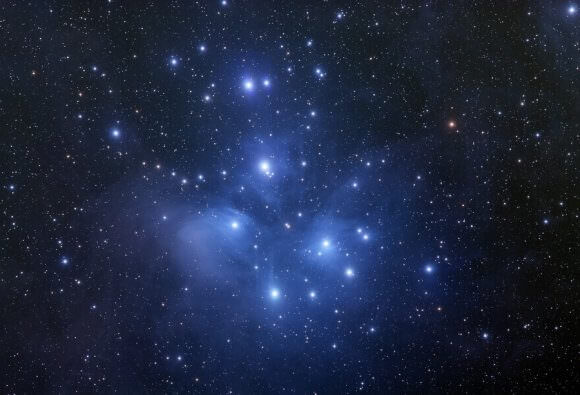Welcome back to Messier Monday! In our ongoing tribute to the great Tammy Plotner, we take a look at the universally-renowned cluster known for its seven major points of light - The Pleiades Cluster!
During the 18th century, famed French astronomer Charles Messier noted the presence of several "nebulous objects" in the night sky. Having originally mistaken them for comets, he began compiling a list of them so that others would not make the same mistake he did. In time, this list (known as the Messier Catalog) would come to include 100 of the most fabulous objects in the night sky.
One of these is the famous Pleiades Cluster, also known as the Seven Sisters (and countless other names). An open star cluster located approximately 390 to 456 light years from Earth in the constellation of Taurus, this cluster is dominated by very bright, hot blue stars. Being both bright and of one of the nearest star clusters to Earth, this cluster is easily visible to the naked eye in the night sky.
Description:
The nine brightest stars of the Pleiades are named for the Seven Sisters of Greek mythology: Sterope, Merope, Electra, Maia, Taygete, Celaeno, and Alcyone, along with their parents Atlas and Pleione. To the X-ray telescopes on board the orbiting ROSAT observatory, the cluster also presents an impressive, but slightly altered, appearance.

An optical image of the Pleiades. Credit: NOAO/AURA/NSF
This false color image was produced from ROSAT observations by translating different X-ray energy bands to visual colors - the lowest energies are shown in red, medium in green, and highest energies in blue. (The green boxes mark the position of the seven brightest visual stars.)
The Pleiades stars seen in X-rays have extremely hot, tenuous outer atmospheres called coronas and the range of colors corresponds to different coronal temperatures. This helps to determine mass and the presence of brown dwarf stars within Messier 45. As Greg Ushomirsky (et al) said in a 1998 study:
"We present an analytic calculation of the thermonuclear depletion of the light elements lithium, beryllium, and boron in fully convective, low-mass stars. Under the presumption that the pre-main-sequence star is always fully mixed during contraction, we find that the burning of these rare light elements can be computed analytically, even when the star is degenerate. Using the effective temperature as a free parameter, we constrain the properties of low-mass stars from observational data, independently of the uncertainties associated with modeling their atmospheres and convection. Our analytic solution explains the dependence of the age at a given level of elemental depletion on the stellar effective temperature, nuclear cross sections, and chemical composition. These results are also useful as benchmarks to those constructing full stellar models. Most importantly, our results allow observers to translate lithium nondetections in young cluster members into a model-independent minimum age for that cluster. Using this procedure, we have found lower limits to the ages of the Pleiades (100 Myr) and Alpha Persei (60 Myr) clusters. Dating an open cluster using low-mass stars is also independent of techniques that fit upper main-sequence evolution. Comparison of these methods provides crucial information on the amount of convective overshooting (or rotationally induced mixing) that occurs during core hydrogen burning in the 5-10 Mo stars typically at the main-sequence turnoff for these clusters."
As one of the closest of star clusters to our solar system, M45 is dominated by hot blue stars that have only formed within the last 100 million years. Alongside Maia is a reflection nebula discovered by Tempel faint nebula which accompanies Merope was discovered by master observer E.E. Barnard. These were first believed to be left over from the formation of the cluster.

Messier 45. Credit: Boris Stromar
However, it didn't take many years of observation of proper motion for astronomers to realize the Pleiades were actually moving through a cloud of interstellar dust. While this pleasing blue group is still only 440 light years away, it only has about another 250 million years left before tidal interactions will tear it apart. By then, its relative motion will have carried it from the constellation of Taurus to the southern portion of Orion!
Of course, many observers aren't quite sure if they are seeing the nebulosity in M45 or not. Chances are, if you're seeing what appears to be a "fog" around the bright stars - you're on it. Only large aperture or photography reveals the full extent of the reflection nebula... and there's a whole lot of scientific reasons for it. Said Steven Gibson (et al) in a 2003 study:
"The scattering geometry analysis is complicated by the blending of light from many stars and the likely presence of more than one scattering layer. Despite these complications, we conclude that most of the scattered light comes from dust in front of the stars in at least two scattering layers, one far in front and extensive, the other nearer the stars and confined to areas of heavy nebulosity. The first layer can be approximated as an optically thin, foreground slab whose line-of-sight separation from the stars averages ~0.7 pc. The second layer is also optically thin in most locations and may lie at less than half the separation of the first layer, perhaps with some material among or behind the stars. The association of nebulosity peripheral to the main condensation around the brightest stars is not clear. Models with standard grain properties cannot account for the faintness of the scattered UV light relative to the optical. Some combination of significant changes in grain model albedo and phase function asymmetry values is required. Our best-performing model has a UV albedo of 0.22+/-0.07 and a scattering asymmetry of 0.74+/-0.06. Hypothetical optically thick dust clumps missed by interstellar sight line measurements have little effect on the nebular colors but might shift the interpretation of our derived scattering properties from individual grains to the bulk medium."
Since the Pleaides really is close to our solar system, have astronomers been able to detect anything within its boundaries that has surprised them? The answer is yes. according to a 1998 study by E.L. Martin:
"We present the discovery of an object in the Pleiades open cluster, named Teide 2, with optical and infrared photometry that places it on the cluster sequence slightly below the expected substellar mass limit. We have obtained low- and high-resolution spectra that allow us to determine its spectral type (M6), radial velocity, and rotational broadening and to detect H? in emission and Li I in absorption. All the observed properties strongly support the membership of Teide 2 in the Pleiades. This object has an important role in defining the reappearance of lithium below the substellar limit in the Pleiades."

The M45 cluster. Credit: Wikipedia Commons/Did23
And what star is that? One cataloged as known as HD 23514, which has a mass and luminosity a bit greater than our Sun. But it's a star surrounded by an extraordinary number of hot dust particles. "Unusually massive amounts of dust, as seen at the Pleiades and Aries stars, cannot be primordial but rather must be the second-generation debris generated by collisions of large objects," said Song, ""Collisions between comets or asteroids wouldn't produce anywhere near the amount of dust we are seeing."
The astronomers analyzed emissions from countless microscopic dust particles and concluded that the most likely explanation is that the particles are debris from the violent collision of planets or planetary embryos. Song calls the dust particles the "building blocks of planets," which can accumulate into comets and small asteroid-size bodies and then clump together to form planetary embryos, eventually becoming full-fledged planets.
"In the process of creating rocky, terrestrial planets, some objects collide and grow into planets, while others shatter into dust," Song said. "We are seeing that dust."
History of Observation:
The recognition of the Pleiades dates back to antiquity, and its stars are known by many names in many cultures. The Greeks and Romans referred to them as the "Starry Seven," the "Net of Stars," "The Seven Virgins," "The Daughters of Pleione," and even "The Children of Atlas." The Egyptians referred to them as "The Stars of Athyr;" the Germans as "Siebengestiren" (the Seven Stars); the Russians as "Baba" after Baba Yaga - the witch who flew through the skies on her fiery broom.

The Pleiades by Elihu Vedder (1885). Credit: Metropolitan Museum of Art, New York City.
The Japanese call them "Subaru;" Norsemen saw them as packs of dogs; and the Tongans as "Matarii" (the Little Eyes). American Indians viewed the Pleiades as seven maidens placed high upon a tower to protect them from the claws of giant bears, and even Tolkien immortalized the star group in The Hobbit as "Remmirath." The Pleiades were even mentioned in the Bible! So, you see, no matter where we look in our "starry" history, this cluster of seven bright stars has been part of it.
Charles Messier would log it on March 4, 1769 where his only comment would be: "Cluster of stars known by the name Pleiades: the position reported is that of the star Alcyone." Even though historic astronomers did little more than comment on M45's presence, we're still glad the Charles logged it - for it never received another "official" catalog designation!
Locating Messier 45:
Most normally the Pleiades are easily found with the unaided eye as a very visible cluster of stars about a hand span northwest of Orion. However, if sky conditions are bright, M45 might be a little more difficult to spot. If so, look for bright, red star Aldebaran and set your sights about 10 degrees (an average fist width) northwest.
It will show very easily in any size optics and under virtually any conditions - except for clouds and daylight! Messier 45's large size makes it an ideal candidate for binoculars, where it will cover about half the average field of view. When using a telescope, chose the least amount of magnification possible to see the entire cluster and use higher magnification to study individual stars.

The location of the Centaurus constellation in the southern sky. Credit: IAU/Sky & Telescope magazine/Roger Sinnott & Rick Fienberg
And as always, here are the quick facts on this Messier Object to help you get started:
Object Name: Messier 45
Alternative Designations: M45, the Pleiades, Seven Sisters, Subaru
Object Type: Open Galactic Star Cluster, Reflection Nebula
Constellation: Taurus
Right Ascension: 03 : 47.0 (h:m)
Declination: +24 : 07 (deg:m)
Distance: 0.44 (kly)
Visual Brightness: 1.6 (mag)
Apparent Dimension: 110.0 (arc min)
We have written many interesting articles about Messier Objects here at Universe Today. Here's Tammy Plotner's Introduction to the Messier Objects, , M1 – The Crab Nebula, M8 – The Lagoon Nebula, and David Dickison's articles on the 2013 and 2014 Messier Marathons.
Be to sure to check out our complete Messier Catalog. And for more information, check out the SEDS Messier Database.
Sources:
No comments:
Post a Comment